- 09
- Dec
Čo je aktuálny?
What is the electric current? First recall, what is the definition of current we have learned?

Jednoducho povedané, smerový pohyb nabitých častíc vo vodiči je elektrický prúd.
Len keď má látka nabité častice, ktoré sa môžu voľne pohybovať, môže prenášať elektrický prúd – teda viesť elektrinu. Tieto nabité častice, ktoré sa podieľajú na vedení, sa nazývajú nosiče. Napríklad pre kovy môžu ako nosiče pôsobiť iba vonkajšie elektróny atómov.
„Smerový pohyb“ v definícii elektrického prúdu je často nepochopený. Mnoho ľudí si myslí, že sa to týka pohybu s určitým smerom, samozrejme, že nie! Nezmení sa smer pohybu elektrónov v obvode striedavého prúdu?
In fact, orienteering is relative to “random movement”!
Since electrons are microscopic particles, they must be in thermal motion all the time. Thermal motion is a random motion, as shown in the figure below. 
Tento pohyb je v skutočnosti veľmi rýchly. Napríklad v kovoch pri izbovej teplote je rýchlosť elektronického tepelného pohybu rádovo stovky kilometrov za sekundu!
Ak sa pozorne pozriete na tento náhodný pohyb, zistíte, že smer pohybu každej častice je v každom okamihu náhodný. Ak spočítate vektory rýchlosti týchto častíc, výsledok je takmer nulový.
Teraz pridajte k vodiču elektrické pole a elektrón superponuje smerový pohyb na základe náhodného pohybu. Za predpokladu, že elektrické pole je po určitú dobu vľavo, pohyb elektrónov vyzerá nasledovne. Červené guľôčky predstavujú atómy kovu na kryštálovej mriežke a rýchlo sa pohybujúce bodky predstavujú voľné elektróny. 
Does it look fast? That’s because electronic movement is really fast! But in fact, the random motion, which accounts for a large proportion of it, does not contribute to the current. When the random motion is eliminated, the rest is just like the slow look below.
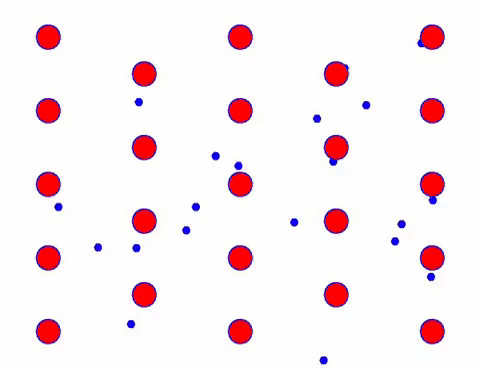
Indeed, the directional movement of electrons is much slower than the speed of thermal movement. This “grinding” movement of electrons is called drift, or “drift”. Sometimes, electrons will run in the opposite direction because of collisions with atoms. But in general, electrons move in one direction.
Ak elektrické pole zmení smer, zmení sa aj smer driftu elektrónov.
Preto tento druh smerového pohybu znamená, že súčet rýchlostí všetkých elektrónov zúčastňujúcich sa vedenia v určitom čase nie je nulový, ale vo všeobecnosti je v určitom smere. Tento smer je možné kedykoľvek zmeniť, a to je prípad striedavého prúdu.
Therefore, current is not so much the “directional movement” of electric charge as it is the “collective movement” of electric charge.
Veľkosť prúdu vo vodiči je vyjadrená intenzitou prúdu. Intenzita prúdu je definovaná ako množstvo elektriny, ktorá prejde prierezom vodiča za jednotku času, tj
Naučili sme sa niektoré fyzikálne veličiny, ktoré obsahujú slovo „intenzita“, ako je intenzita elektrického poľa a intenzita magnetickej indukcie. Vo všeobecnosti predstavujú rozdelenie za jednotku času, jednotku plochy (alebo jednotku objemu, jednotkový priestorový uhol). Slovo „intenzita“ v súčasnej intenzite však neodráža aktuálne rozdelenie plochy.
V skutočnosti je za distribúciu prúdu do oblasti zodpovedná iná fyzikálna veličina, ktorou je hustota prúdu.
Since the essence of electric current is the directional movement of electric charge, there must be a certain relationship between current intensity and drift speed!
In order to obtain this relationship, we must first clarify a concept-carrier concentration, that is, the number of carriers in a unit volume, which is expressed by .
It is assumed that the conductor cross section is, the carrier concentration is, the drift velocity is, and the charged charge is.
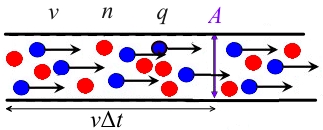
Then the charge in the conductor on the left side of the surface is, and these charges will pass through the surface within a certain period of time, so
Ide o mikroskopické vyjadrenie intenzity prúdu.
Current density is the apportionment of current to area, so the magnitude of current density is, but it is defined as a vector, and the direction is the direction of the drift velocity vector of the positively charged carriers, so the drift of electrons in the metal can be obtained from this Speed, as an example below.
Uvažujme medený drôt za predpokladu, že každý atóm medi prispieva elektrónom ako nosičom. Existuje 1 mol medi, jej objem je, molárna hmotnosť je, hustota je, potom je koncentrácia nosiča medeného drôtu
Where is Avogadro’s constant. The density of copper is found, and the value obtained by substituting is about unit/cubic meter.
Za predpokladu, že polomer medeného drôtu je 0.8 mm, pretekajúci prúd je 15A, = 1.6 C a driftová rýchlosť elektrónov sa vypočíta ako
It can be seen that the drift speed of electrons is indeed very small.
Pre tých, ktorí študujú obvody, je vyššie uvedená úplná definícia prúdu.
But in physics, the above definition of current is actually only a narrow definition. More general currents are not limited to conductors, as long as the movement of electric charges is current. For example, when the electrons of a hydrogen atom move around the nucleus, an electric current is formed in its orbit.
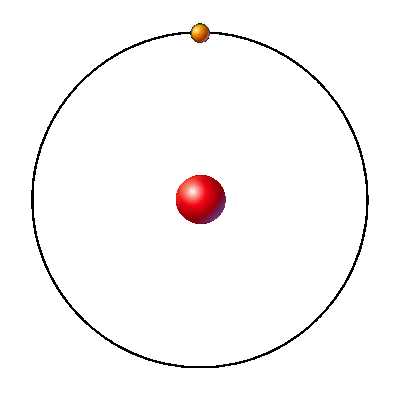
Suppose the amount of electronic charge is and the period of movement is. Then every time that elapses, there is such a large amount of charge passing through any cross section of the loop, so the current intensity is based on the relationship between period, frequency and angular velocity, and the current can also be expressed as
Ďalší príklad, nabitý kovový disk, ktorý sa otáča okolo svojej osi, tiež vytvára slučkové prúdy s rôznymi polomermi.

Tento druh prúdu nie je normálny vodivý prúd a nemôže generovať Joulovo teplo! Nedá sa vytvoriť skutočný okruh.
V opačnom prípade by ste mi dali výpočet, koľko joulového tepla vygenerujú za sekundu elektróny atómu vodíka?
In fact, the current in vacuum does not satisfy Ohm’s law. Because, for the electric current formed by the movement of charged particles in the vacuum, the carriers are not collided similar to the lattice in the metal, so the vacuum has no resistance and no conductance.
Pohyb elektrických nábojov vytvára elektrický prúd a samotný elektrický náboj budí elektrické pole. To môže ľahko spôsobiť nedorozumenie. Mnoho ľudí si preto myslí, že elektrické pole nabitých častíc, ktoré tvoria elektrický prúd, musí byť vystavené. Ale v skutočnosti pre vodivý prúd vo všeobecnom vodiči prúdia nosiče na pozadí zloženom z veľkého počtu kladne nabitých kovových iónov a samotný vodič je neutrálny!
Tento druh špeciálneho prúdu často nazývame „ekvivalentný prúd“. Ekvivalent tu znamená, že generuje magnetické pole na rovnakom základe ako obyčajný vodivý prúd!
Pripomienka: Nezamieňajte si tu „ekvivalentný prúd“ s „ekvivalentným obvodom“ v analýze obvodu
In fact, when we first studied the magnetic field, the electric current in Biot-Saffar’s law was the generalized electric current that contained this equivalent current. Of course, the conduction current in Maxwell’s equations also refers to the generalized current.
Tí, ktorí študovali fotoelektrický jav, vedia, že pri driftovaní fotoelektrónu z katódy na anódu, ak sa ignoruje vplyv vzduchu, je tento prúd spôsobený pohybom elektrických nábojov vo vákuu a nie je tam žiadny odpor, takže nie je obmedzený Ohmovým zákonom.
Takže, je toto jediná vec o elektrickom prúde vo fyzike?
No! There are also two types, namely magnetizing current and displacement current.
Sú to tiež dva ekvivalentné prúdy, ktoré sa, ako už názov napovedá, zavádzajú aj na vysvetlenie magnetizmu. Inými slovami, odpútali sa od základnej charakteristiky súčasného „pohybu náboja“!
To je úžasné! Neexistuje žiadny pohyb elektrického náboja, tak prečo ho možno nazvať elektrickým prúdom?
Neboj sa a počúvaj ma pomaly.
Najprv sa pozrime na magnetizačný prúd.
Zistilo sa, že magnetizmus je spôsobený pohybom elektriny (zatiaľ neberieme do úvahy vysvetlenie magnetizmu vlastnými vlastnosťami spinu). Na vysvetlenie prirodzeného magnetizmu predložil francúzsky fyzik Ampere hypotézu „molekulárnej cirkulácie“. 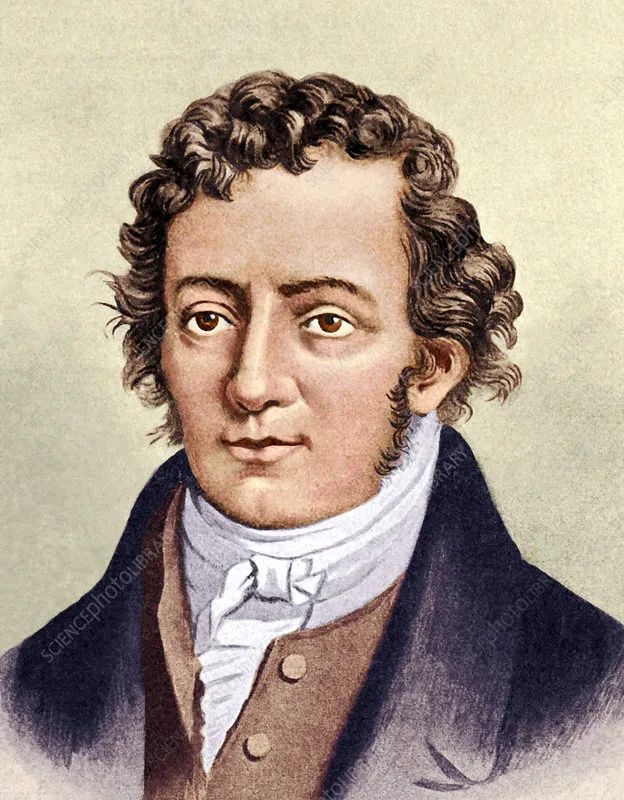
As shown in the figure below, any atom or molecule can be regarded as having an electric charge rotating around the center, forming a tiny loop current, that is, “molecular circulation”.
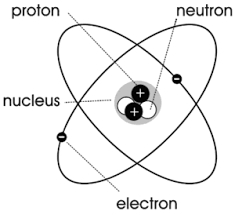
Podľa zákona, že elektrický prúd budí magnetické pole, táto molekulárna cirkulácia vytvorí fyzikálnu veličinu nazývanú magnetický moment. Jeho veľkosť je plocha ohraničená molekulárnou cirkuláciou vynásobená ekvivalentným prúdom molekulárnej cirkulácie a jej smer je v pravotočivej špirále so smerom cirkulácie, tj.
Je zrejmé, že smer magnetického momentu je presne pozdĺž smeru magnetického poľa vytvoreného cirkulujúcim prúdom
. 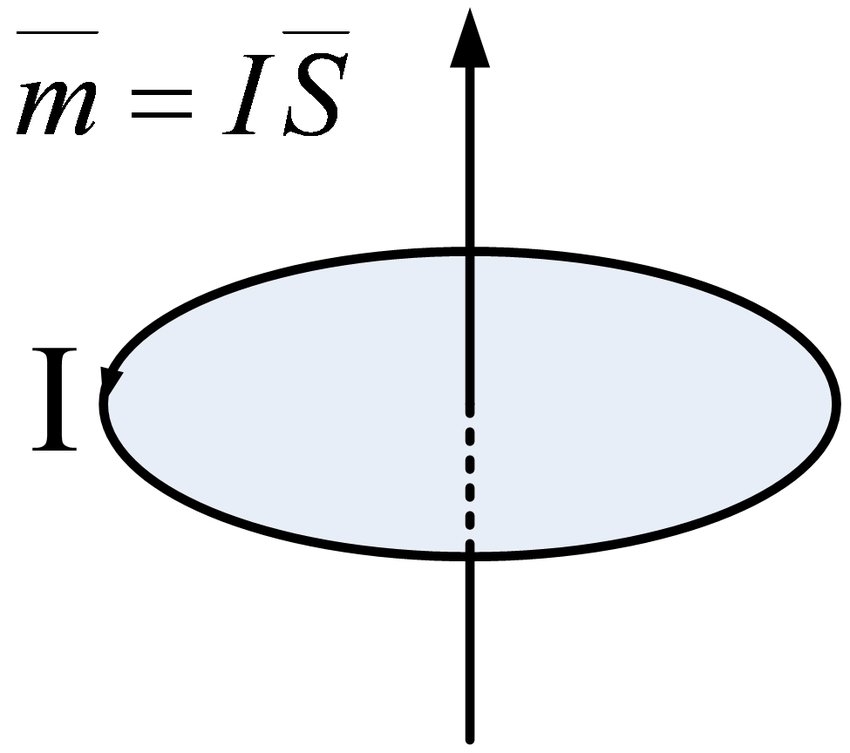
Under normal circumstances, the arrangement of the molecular circulation of a substance is chaotic, so the substance is not magnetic, as shown on the left side of the figure below. When subjected to an external magnetic field, these molecular circulations will be approximately neatly arranged. As shown on the right side of the figure below, their magnetic moments are arranged in one direction as much as possible, just like countless small magnetic needles gathered together to form a total magnetic field, and the whole material composed of them becomes magnetic.
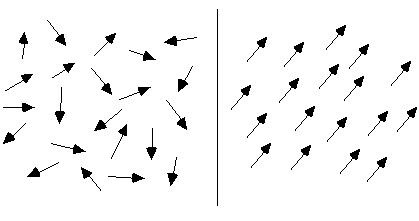
Suppose there is a cylindrical magnet, the inner molecular circulation is neatly arranged, and the sections of each molecular circulation at the edge of the magnet section are connected together to form a large circulation, as shown in the figure below. 
Na základe toho si môžeme myslieť, že tyčový magnet je ako solenoid pod napätím. Inými slovami, na povrchu magnetu je zapletený neviditeľný prúd! Tento druh prúdu nie je možné pripojiť a použiť. Je obmedzený na povrch magnetu. Hovoríme tomu „väzbový prúd“ alebo „magnetizačný prúd“.
Magnetizačný prúd je teda prúd, pretože je rovnaký ako prúd tvorený pohybom skutočných elektrických nábojov, ktoré môžu ekvivalentne vytvárať magnetické pole!
Pozrime sa znova na posuvný prúd.
According to the Ampere’s loop theorem, the integral of the magnetic field strength on a closed path is equal to the flux of the current density on any curved surface bounded by this path, that is, this theorem is called Stokes’ theorem in mathematics. It tells us that the integral of a vector along any closed path must be equal to the flux of its curl (here) to any surface bounded by the closed path.
Keďže ide o matematickú vetu, musí byť vždy správna, pretože matematika je logický systém založený na axiómach.
Preto musí vždy platiť veta o ampérovej slučke!
Talentovaný škótsky fyzik Maxwell však zistil, že keď sa stretol s nestabilným prúdovým obvodom, teorém Ampérovej slučky bol rozporuplný.
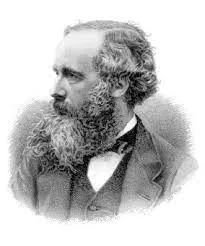
Typický nestabilný prúd sa vyskytuje počas nabíjania a vybíjania kondenzátora. Ako je znázornené na obrázku nižšie, počas krátkej doby nabíjania kondenzátora dochádza k nestabilnému prúdu.
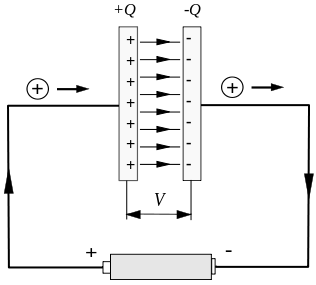
Ale obvod je odpojený medzi doskami kondenzátora, čo spôsobí vážny problém.
Predpokladajme, že uvažujeme uzavretú cestu, ktorá obchádza drôt, ako je znázornené na obrázku nižšie, kruh označený C a zakrivený povrch s ním ako hranicu možno ľubovoľne zvoliť. Na obrázku je zvolená kruhová rovina ohraničená samotným C a cez kondenzátor. Zakrivený povrch ľavej dosky. 
Podľa kruhového povrchu je vidieť, že podľa zakriveného povrchu, ale ako slučkového integrálu sily magnetického poľa, by sa mala určiť jeho hodnota!
Ako na to?
Maxwell verí, že musí byť stanovená Amperova veta o slučke. Teraz, keď nastal problém, musí to byť preto, že časť prúdu sme predtým neobjavili, ale existuje!
Ako teda zistiť túto časť prúdu?
Since the problem is between the plates, start from between the plates.
Through analysis, Maxwell found that regardless of charging or discharging, there is a physical quantity between the capacitor plates at all times that is synchronized with the magnitude and direction of the current. It is the time derivative of the flux of the electric displacement vector, that is, it is defined as the displacement current.
Ak sa usúdi, že táto časť je časťou prúdu, ktorá nebola predtým objavená, potom je úplný prúd teraz. To znamená, že aj keď je obvod medzi doskami odpojený, derivácia toku elektrického posunu a súčet prúdu spolu, ako celok, zaisťuje nepretržitú kontinuitu prúdu.
Going back to the previous contradiction, we now know that, according to the requirements of Stokes’ theorem, when calculating the flux of current density for a closed surface, the density of displacement current should also be considered, that is, the complete ampere loop theorem is therefore, By “discovering” this new current component, the crisis of the Ampere Loop Theorem is resolved!
The reason why “introduction” is not used here, but “discovery” is used here. What I want to emphasize is that this kind of current is not a mathematical compensation, but a real thing, but it has not been discovered before.
Why does it exist in the first place? Because it acts as an electric current, like a conduction current, it excites a magnetic field equivalently, except that there is no movement of electric charges, no wire is required, and no Joule heat can be generated, so it has been ignored!
But it actually exists by itself, just keep a low profile, it has been silently exciting the magnetic field there all the time!
In other words, when we face a magnetic field, the original definition of current is too narrow. The essence of electric current is not the movement of electric charge, it should be something that can excite a magnetic field.
Doteraz boli zavedené viaceré formy prúdu. Všetky existujú objektívne a majú spoločné to, že všetky prúdy môžu rovnako excitovať magnetické pole.
